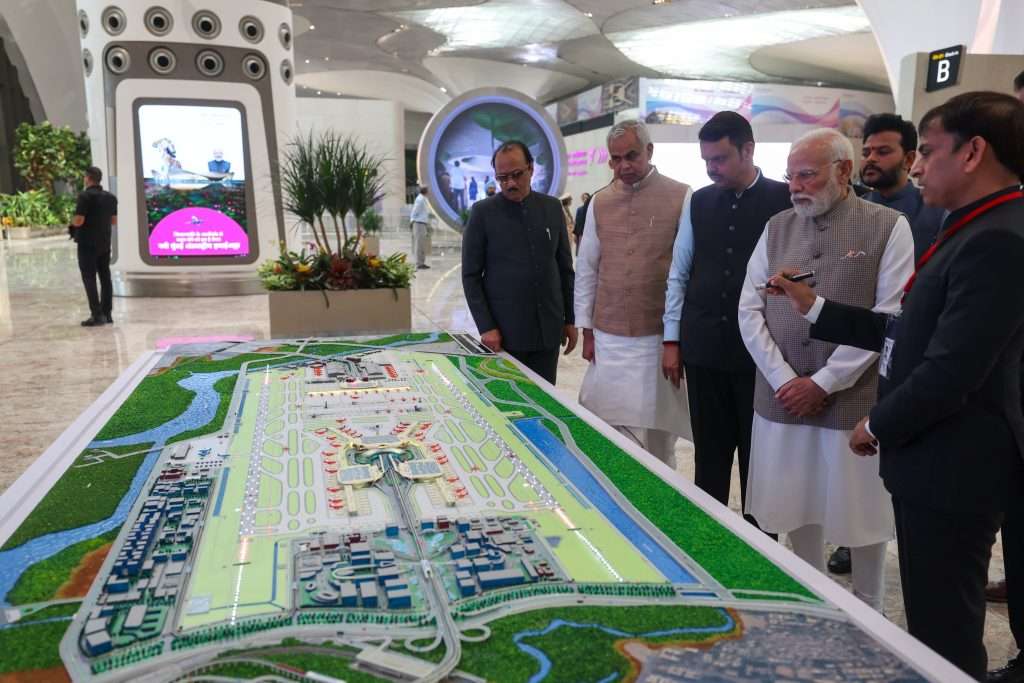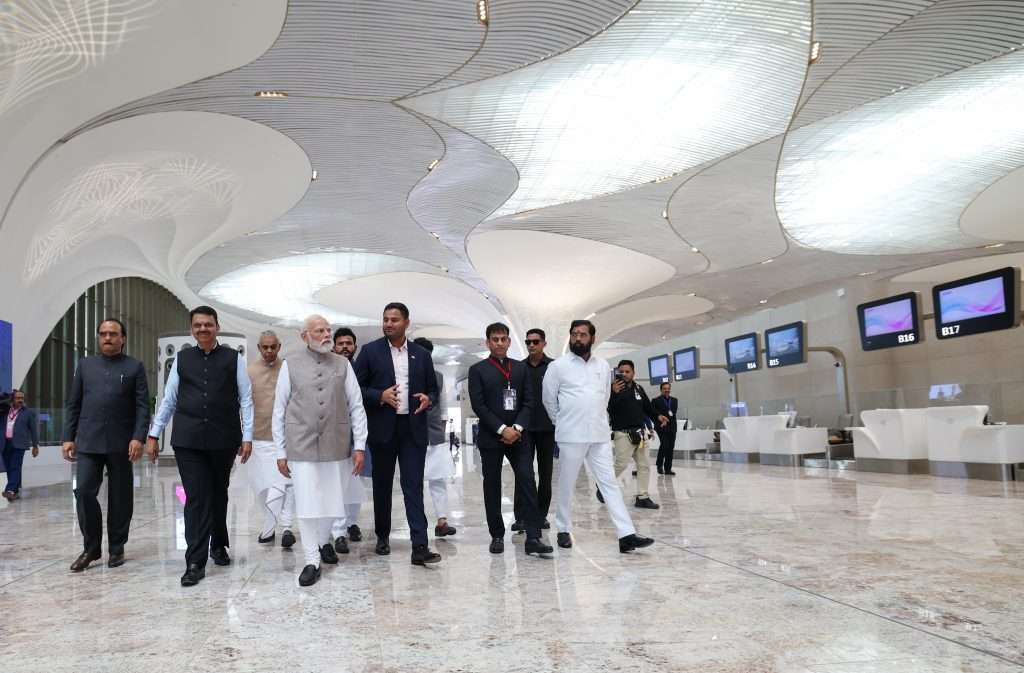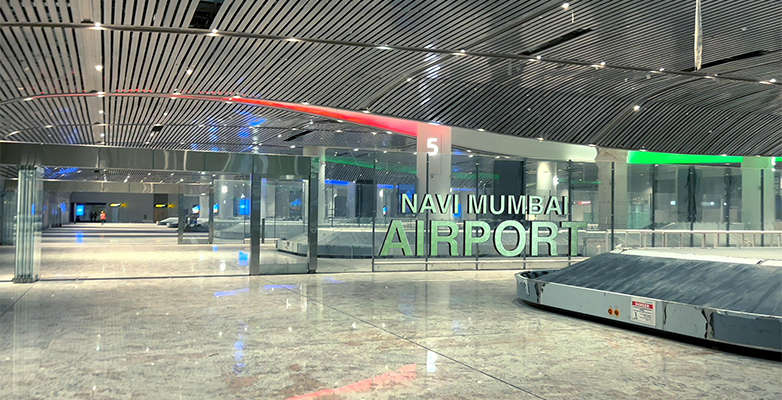Navi Mumbai International Airport Inaugurated by PM Modi: India’s First Fully Digital Airport Set to Begin Flights in December 2025

Navi Mumbai International Airport has officially been inaugurated by Prime Minister Narendra Modi on Wednesday, October 8, marking a historic milestone in India’s aviation sector. The state-of-the-art facility, located in Ulwe, Navi Mumbai, is being hailed as the country’s first fully digital and ‘anxiety-free’ airport, designed to redefine passenger experience through cutting-edge technology and sustainability.
Contents
A Landmark Moment for India’s Aviation Infrastructure
Built at an estimated cost of ₹19,650 crore, the Navi Mumbai International Airport (NMIA) covers an expansive area of 1,160 hectares. The airport is expected to significantly reduce the load on the existing Chhatrapati Shivaji Maharaj International Airport (CSMIA), which currently handles one of the highest passenger volumes in India.
The inauguration marks the beginning of Phase 1, with full-scale operations expected to start by December 2025. Ticket sales for the first flights are likely to begin by the end of October, with IndiGo, Akasa Air, and Air India Express among the first airlines ready to operate.
Prime Minister Modi, after taking a walkthrough of the facility, described NMIA as a symbol of “Viksit Bharat” and a gateway to new opportunities for Maharashtra. “With this new airport, farmers from Maharashtra will be connected to markets across the Middle East and Europe. It will attract investments and create thousands of jobs,” he said during his address at the event.




Digital Features for an ‘Anxiety-Free’ Travel Experience
The Navi Mumbai International Airport stands out as India’s first fully digital airport, offering several advanced facilities for passengers. Travelers can pre-book parking slots, schedule baggage drop-offs, and even access real-time updates on baggage carousel numbers via mobile notifications.
Arun Bansal, CEO of Adani Airports Holdings Limited (AAHL), emphasized that these innovations aim to eliminate travel-related stress. “Passengers will get updates directly on their phones — for instance, a message informing them their bag is number 20 on the carousel. Every aspect is designed to make travel faster, simpler, and anxiety-free,” Bansal explained.
The airport’s architecture is equally striking. Designed by the British firm Zaha Hadid Architects, it features a lotus-inspired design representing India’s national flower.







India’s New Global Aviation Hub
Once operational, NMIA will handle an estimated 20 million passengers annually (MPPA) in its first phase, with a cargo capacity of 0.5 million metric tonnes (MMTPA). The airport’s final phase will include four terminals and two parallel runways, both ‘Code F’ compliant with a 3,700-meter length and 60-meter width, capable of handling large international aircraft.
The International Air Transport Association (IATA) has assigned the airport the global code NMI, already adopted by multiple airlines for ticket booking systems.
Also read: PM Modi Launches Mumbai One App: India’s First Integrated Travel Platform For Seamless Commuting Across Mumbai
Government Vision and Connectivity Plans
Union Civil Aviation Minister Ram Mohan Naidu Kinjarapu, present at the inauguration, highlighted the project as a turning point for Indian aviation. “Navi Mumbai is not just an airport; it’s a symbol of India’s growing stature on the world stage. Under PM Modi’s leadership, the aviation sector has seen tremendous transformation — from regional connectivity to building 90 new airports in just 11 years,” he said.
The airport will soon become a major hub in the Mumbai Metropolitan Region, connecting to key infrastructure projects like the Mumbai Trans Harbour Link (MTHL), Metro Lines, and Navi Mumbai Coastal Road. Work is already in progress to ensure multimodal connectivity for seamless travel.
From Inauguration to Operation – What’s Next
While the official inauguration has taken place, full-scale operations are still under development. Similar to Goa’s MOPA airport — inaugurated in December 2022 and operationalized three weeks later — NMIA’s commercial flights will begin in stages.
The first phase will operate with limited domestic flights before expanding to international routes by the end of the year. Airlines have already expressed strong interest, with IndiGo likely to operate the first flight from the new airport.
The airport’s capacity will continue to expand with the construction of a dedicated VVIP terminal, scheduled to begin in 2026 and complete by 2030. Once fully developed, NMIA will have the ability to handle 90 million passengers annually, nearly matching the capacity of Delhi’s Indira Gandhi International Airport.
A Step Towards a Future-Ready India
The Navi Mumbai International Airport represents India’s leap toward a future where air travel is faster, smarter, and more sustainable. Its fully digital ecosystem, efficient operations, and world-class design position it as a model for upcoming airports across the country.
With the first flights expected by December 2025, Mumbai is officially set to join the ranks of global cities like London, New York, and Tokyo that operate multiple international airports — strengthening India’s aviation map and global connectivity.

